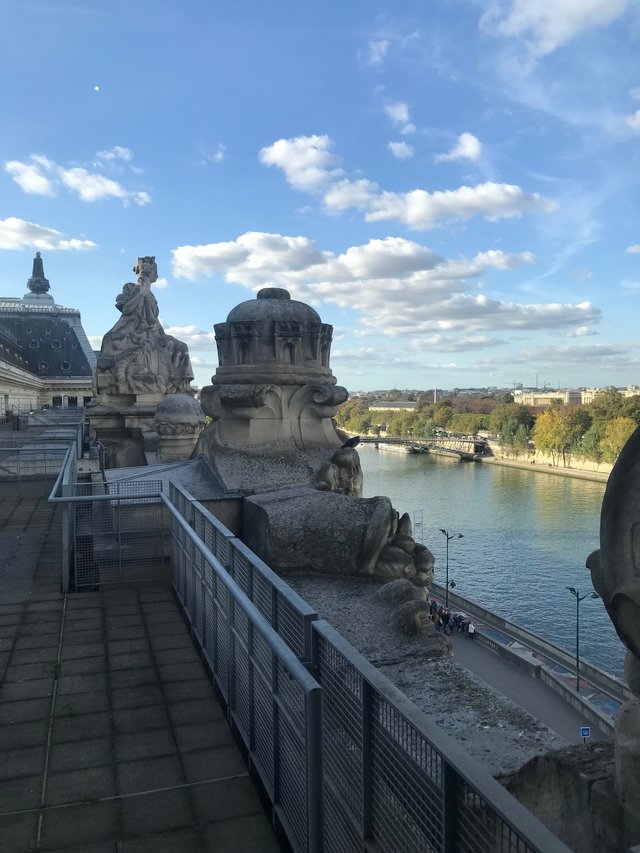The Art of My Trip: At the Musée d'Orsay, Paris
My last day in Paris I spent in an old train station. And while there weren't any trains, busses, or limousines, running... I ended up revisiting all of the places in France in a single, delightful afternoon. I was roaming the Musée d'Orsay, one of the most interesting museums I've ever seen. And it was The Art of My Trip.

The Musée d'Orsay was originally Gare d'Orsay. Constructed around 1900 during the golden age of train travel, the station was considered modern and elegant in its day. Located on the left bank of the Seine, it is directly across this majestic waterway from the Tuileries Garden. And, the Musée d'Orsay is a short walk to its more famous cousin, the Louvre.
Converted to a museum that hosts primarily French art, it opened in 1986 and has quickly become among the world's twenty most visited art galleries. Home to works of many masters of the craft such as Van Gogh, Monet, Cézanne, and Henri Matisse, it is a French feast for the eyes through art!

The Musée d'Orsay comprises three primary levels. On the main level, a vast, open space houses sculptures that stand in the area of the old train station platforms. The two higher floors are a system of rooms that house paintings, drawings, and other exhibits, with an open balcony looking to the floors below. All his is covered by the museum's vaulted atrium, a gold and glass chef-d'oeuvre in and of itself.


Over the week-long stay in France, I visited Rouen and Montmarte. I toured the Louvre and the Tuileries Gardens. I sat in outdoor cafes and wandered the streets of Paris, taking in all the sights. These places were on display at the Musée d'Orsay in acrylic, painted by the famous hands of the most talented artists from days long gone.
Of all the great French artists, Van Gogh remains one of the most influential. Above, his The Starry Night is one of the most recognizable paintings in the world.

On my side trip to Rouen, I visited the Cathedral of Rouen. This gothic church was the subject of a series of paintings by Claude Monet at the turn of the 20th century.
With over 35 separate paintings of this same scene, Monet sought to capture the essence of both his craft and this amazing Cathedral.


While in Montmartre, I attended the annual Grape Harvest Festival, the Fête des Vendanges. High atop the streets of Paris, Montmartre offers a view of Paris, and the Musée d'Orsay, itself, from the stairs of the Basilica Sacré-Cœur.

In this, one of Renoir's most important works, the artist captures a scene of the vitality and splendor of Parisian life in Montmartre in the 1870s.

Ambling around the Rue Montorgueil in the 1st arrondissement offers plenty of restaurants, cafés, bakeries, and other shopping to Parisians and tourists, alike. Captured here in Monet's The Rue Montorgueil in Paris, 1878, again, art creates life!

Even the museum's cafeteria is a work of art!

The Seine commands Paris. Ever present, it winds its way through the heart of this great city.

The Musée d'Orsay is a fabulous museum. Although much smaller than the Louvre, the museum offers some of the best of French art. Easily seen over the course of half a day, you'll definitely want to make sure you get here any time you find yourself in Paris.
Cheers!
All content and images are original except those indicated below.
Sources:
Thumbnail and background images: musee-orsay.fr
Historical Background information:
musee-orsay.fr
claude-monet.com
wikipedia.org

Congratulations @braveboat! You received a bright smile from TravelFeed. Our eyes were beaming while reading your post. 😁
Thanks for using TravelFeed!
@smeralda (TravelFeed team)
PS: Have you joined our Discord yet? This is where over 1000 members of the TravelFeed come together to chat. Join us!